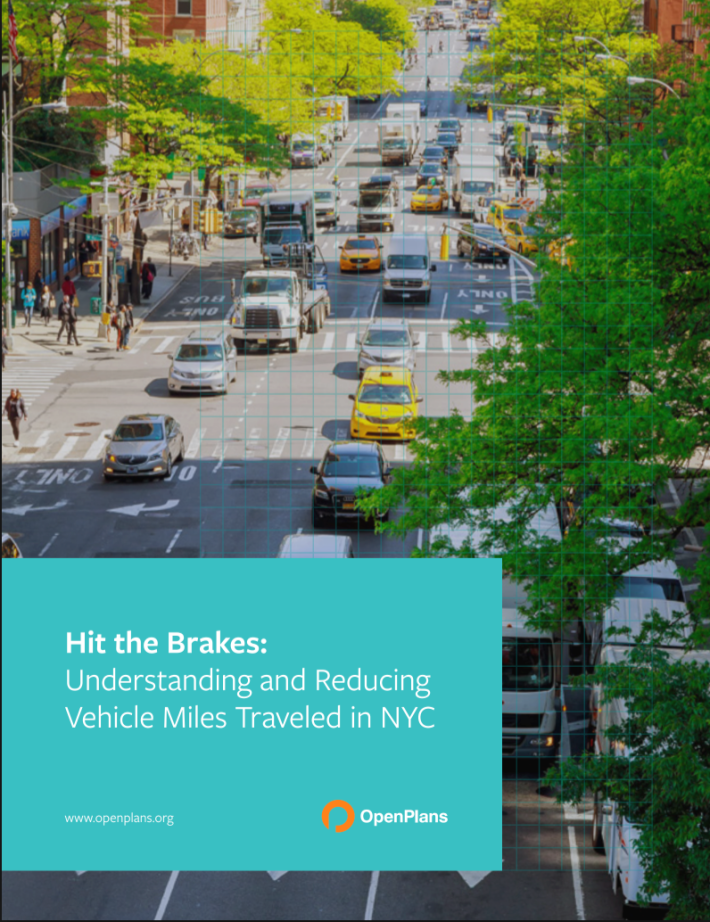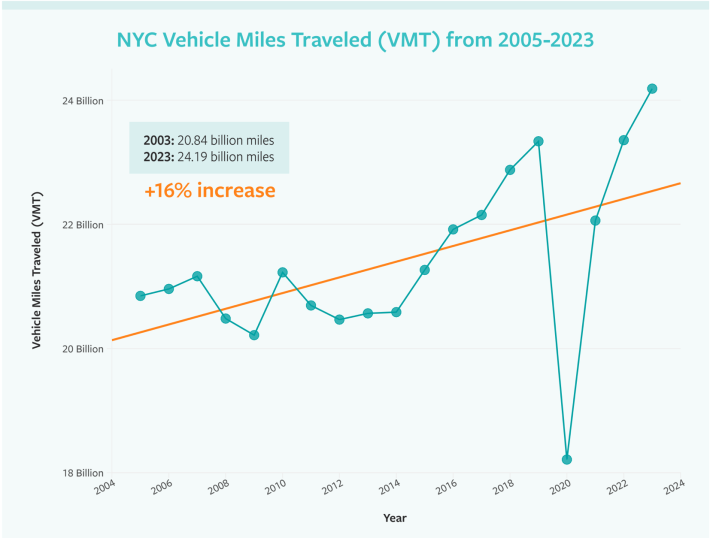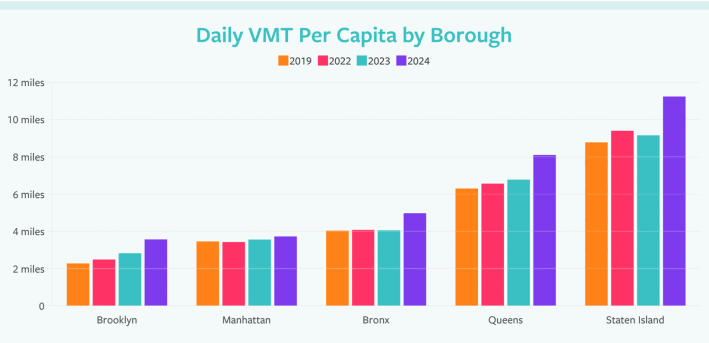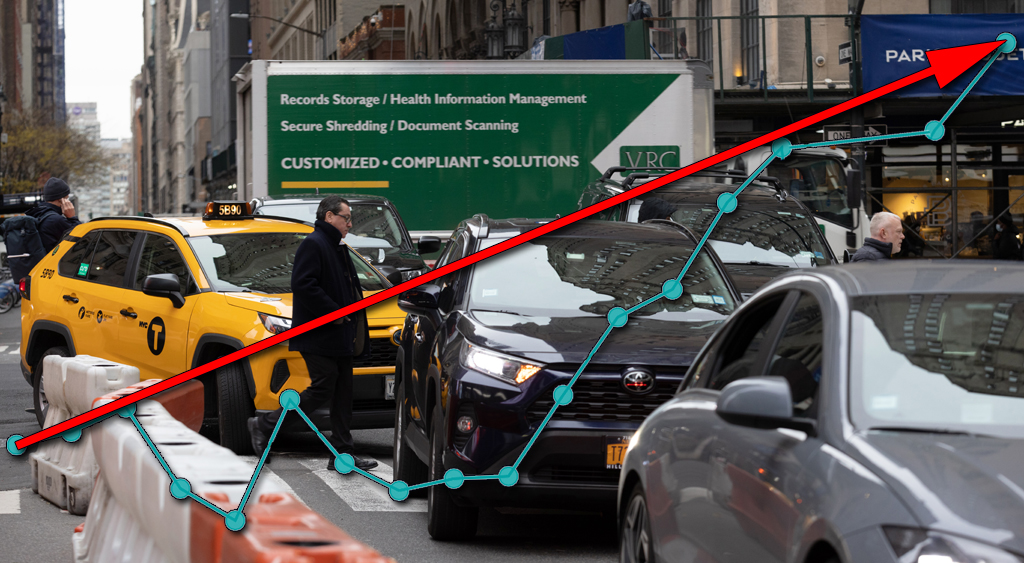New York City needs a U-turn on driving.

The number of miles driven within the five boroughs is increasing — a trend that both challenges efforts to promote more sustainable modes of transportation while it also undermines Vision Zero street safety initiatives, pollution reduction efforts and the traffic mitigation of congestion pricing, a new report makes clear.
The analysis, "Hit the Brakes: Understanding and Reducing Vehicle Miles Traveled in NYC," reveals that VMTs have risen by 16 percent between 2005 and 2023, even though the population of the city rose only 1.4 percent in that period. More than 24 billion miles were driven last year in the city. The launch of congestion pricing has started a decline in that trend, but not by nearly as much as the years'-long rise.
And the rise in VMTs is not, as commonly citied, fueled by Ubers and Lyfts — 80 percent of VMTs in the city are from private vehicles, not cabs. That portion has been more or less consistent for years.

In other words, drivers have met the enemy ... and it is them.
“We’ve allowed more car owners to drive more miles across the five boroughs. But it doesn’t have to be this way,” said Sara Lind, the co-executive director of Open Plans (which, full disclosure, shares a parent company with Streetsblog). "If we don’t act now to reclaim our streets, reduce VMT, and give New Yorkers real, safer alternatives to driving, we’ll fail on our safety, equity, and climate goals. This report not only shines a light on the scale of the problem; it also offers a roadmap to get us out of it.”
Additional findings are just as frightening for livable streets advocates:
- Per capita driving is way up: The average car owner drove 22 percent more miles between 2019 and 2023, according to Replica, a firm that models traffic data.
- Car ownership is up 10 percent since 2010, though the population rose only 1 percent during that same period.
- For-hire vehicles (aka cabs) comprise just 9 percent of the VMTs in the city in data from 2023, the most recent available numbers. That share of total VMTs has not appreciably changed since 2005, before Ubers and other app-based cabs showed up.
- Driving is up in every borough, even in Manhattan, where very few households have access to a car. And it's especially bad in Staten Island.

Why it matters
The increase in driving confounds virtually every attempt to make New York City a better place, the report argues. Primarily, of course, congestion caused by car drivers hurts the hundreds of thousands of New Yorkers who rely on buses.
Our buses are, famously, the slowest in the nation, even though "they have the potential to be an exceptional mode of public transportation," the report states.
And, obviously, more driving means more fatalities. In 2024, 253 people were killed on the streets of New York in crashes. Another 53,999 were injured in crashes — or 148 injuries per day.
And more driving means more air pollution. The transportation sector represents the biggest contributor to greenhouse gas emissions, so the double-digit-percentage increase in driving is obviously not helping the city meet its stated goal of reducing climate-affecting gasses by 80 percent by 2050.
Cars also cause noise pollution — and even small reductions in car traffic results in huge reductions in complaints. After congestion pricing launched on Jan. 5, noise complaints to the city's 311 system dropped by 45 percent in the first four months, the report states.
And cars are a drain on the limited resources of working people, consuming 30 percent of the budgets of low-income families, according to the report. "Giving people the option to use non-car modes could save the average American household $1,000 per month — a considerable sum.
Roughly 65 percent of car traffic is "cut-through" traffic, meaning drivers are undermining the quality of life of many of our neighborhoods.
"Residents on streets with heavy traffic had only a quarter of the number of local
friends compared to residents living on streets with low traffic," the report states, citing academic research. "In neighborhoods with high traffic, kids are also less likely to walk to school. Currently, only 11 percent of children walk to school in the US; in 1969, 40 percent of kids did. This decline is a direct result of the
increase in car-based infrastructure."
As such...
Because of all these deleterious effects of rising car use, Open Plans is reiterating its call for livable streets by focusing on its North Star: car-reduction strategies that are not merely goals or hopes or dreams or candy canes.
"People won't volunteer to drive less," the report states. "Policy is needed to change behavior."
That means implementing strategies such as Paris's multi-pronged approach which built more bike infrastructure, banned parking in some commercial districts, demolished urban highways and boosted transit — a strategy that reduced car use by 45 percent, boosted transit use by 30 percent and increased cycling tenfold.
And it literally cleaned the air, as this famous graphic from AirParif shows:
So Open Plans is pushing a simple, three-pronged strategy:
- Bolster alternatives: By reducing car lanes on roadways, building bike lanes, and creating more bus rapid transit, drivers will get a compelling reason to drive less.
- Change the incentives: Congestion pricing helped reduce car use by changing individual drivers' financial considerations before getting behind the wheel. If suddenly, the daily commute is $9 more because of a toll, that changes a driver's behavior. The group also advocates for pedestrianizing some roadways to keep cars out or creating London-style "low-traffic neighborhoods" to reduce the number of cars.
- Change car-friendly policies: In too many places, developers still must include parking spaces in their new projects, a policy that simply encourages car ownership and, therefore, driving. And highway expansions also increase driving. As do the millions of free parking spaces in town.
“To reduce vehicle miles traveled, we don’t need to reinvent the wheel; there are many proven strategies that work," Lind said. "When cities invest in bus rapid transit, low traffic neighborhoods, and people-centered spaces, people have more — and better — options to get around without a car. That’s exactly the kind of approach New York policymakers should be taking after explicitly setting the reduction of VMT as a goal.”






